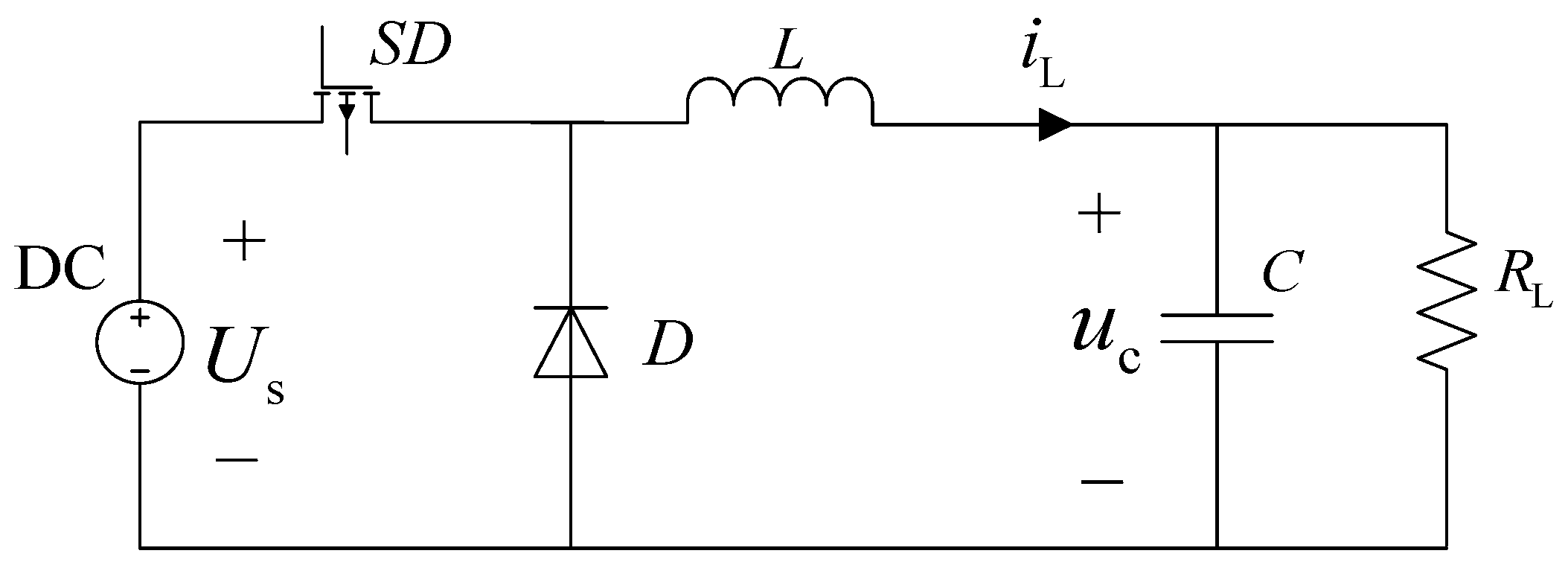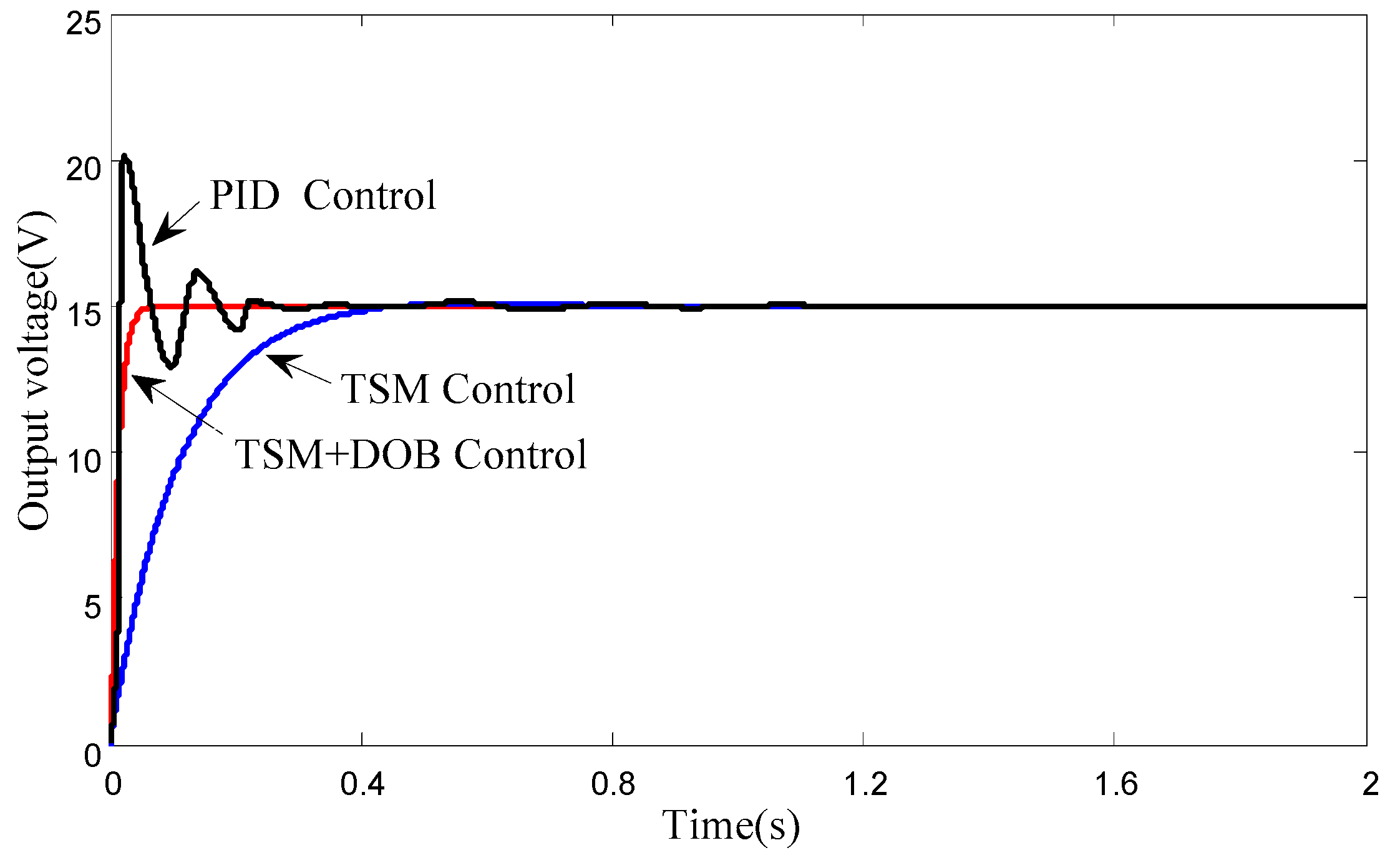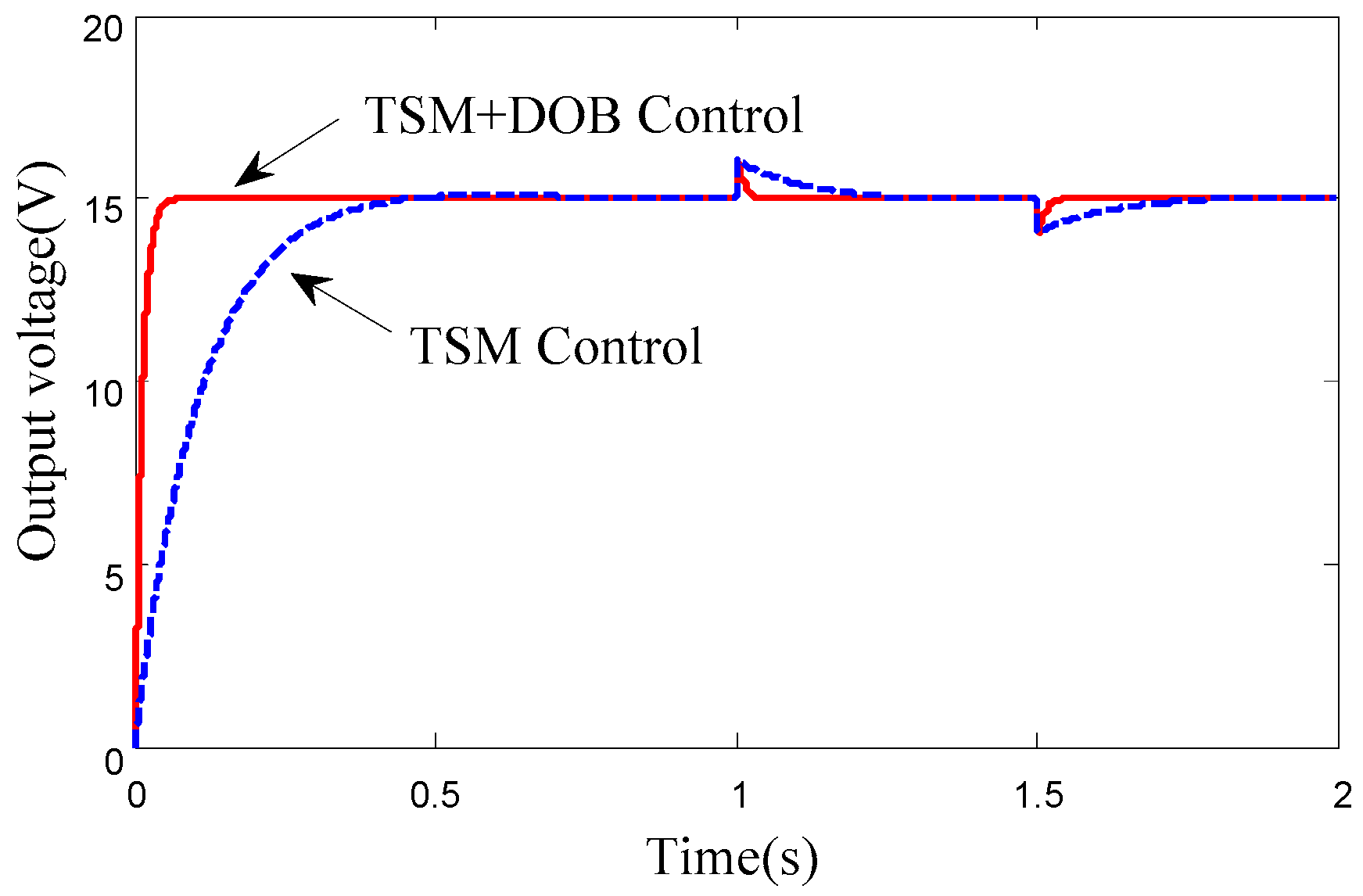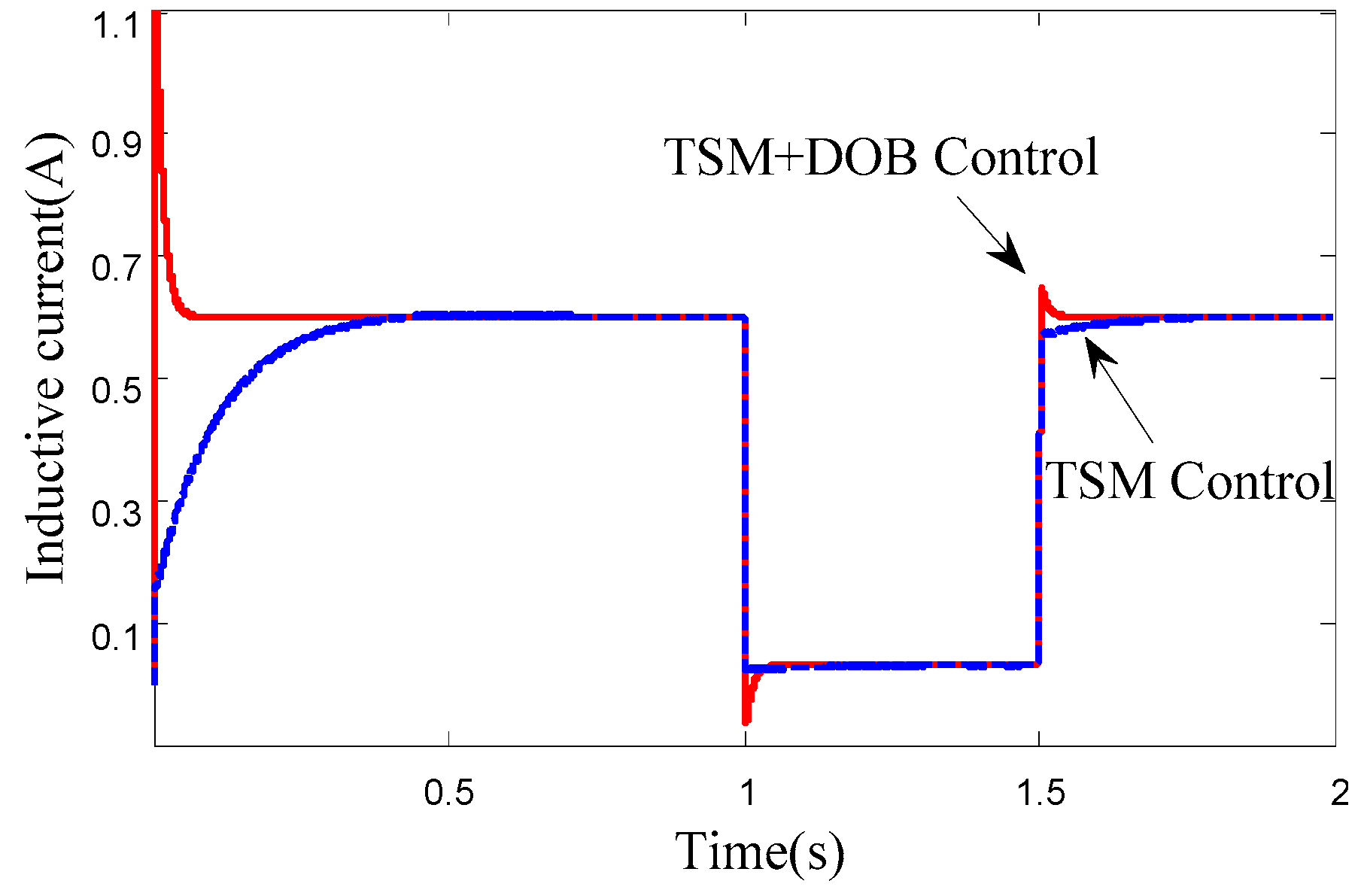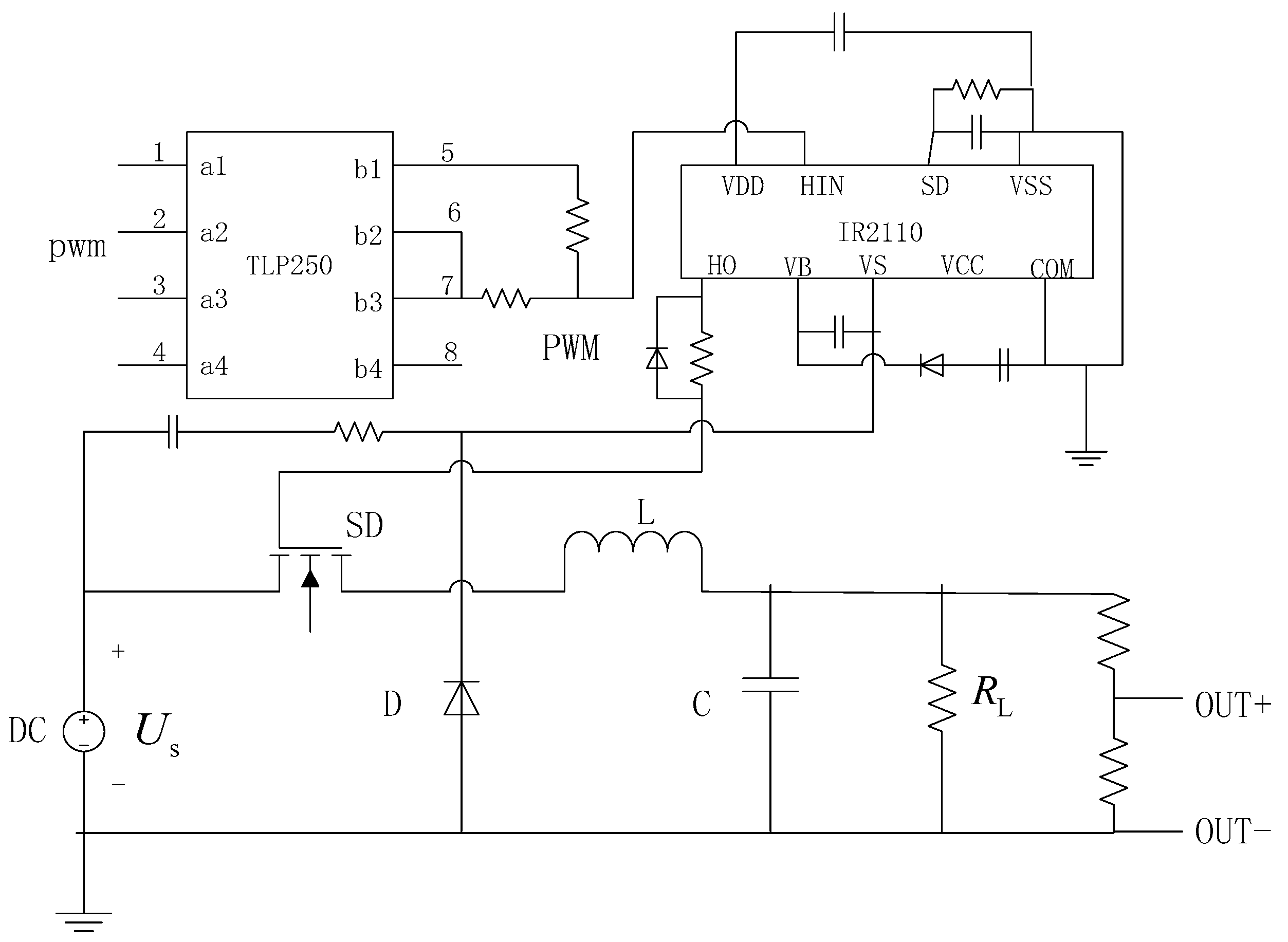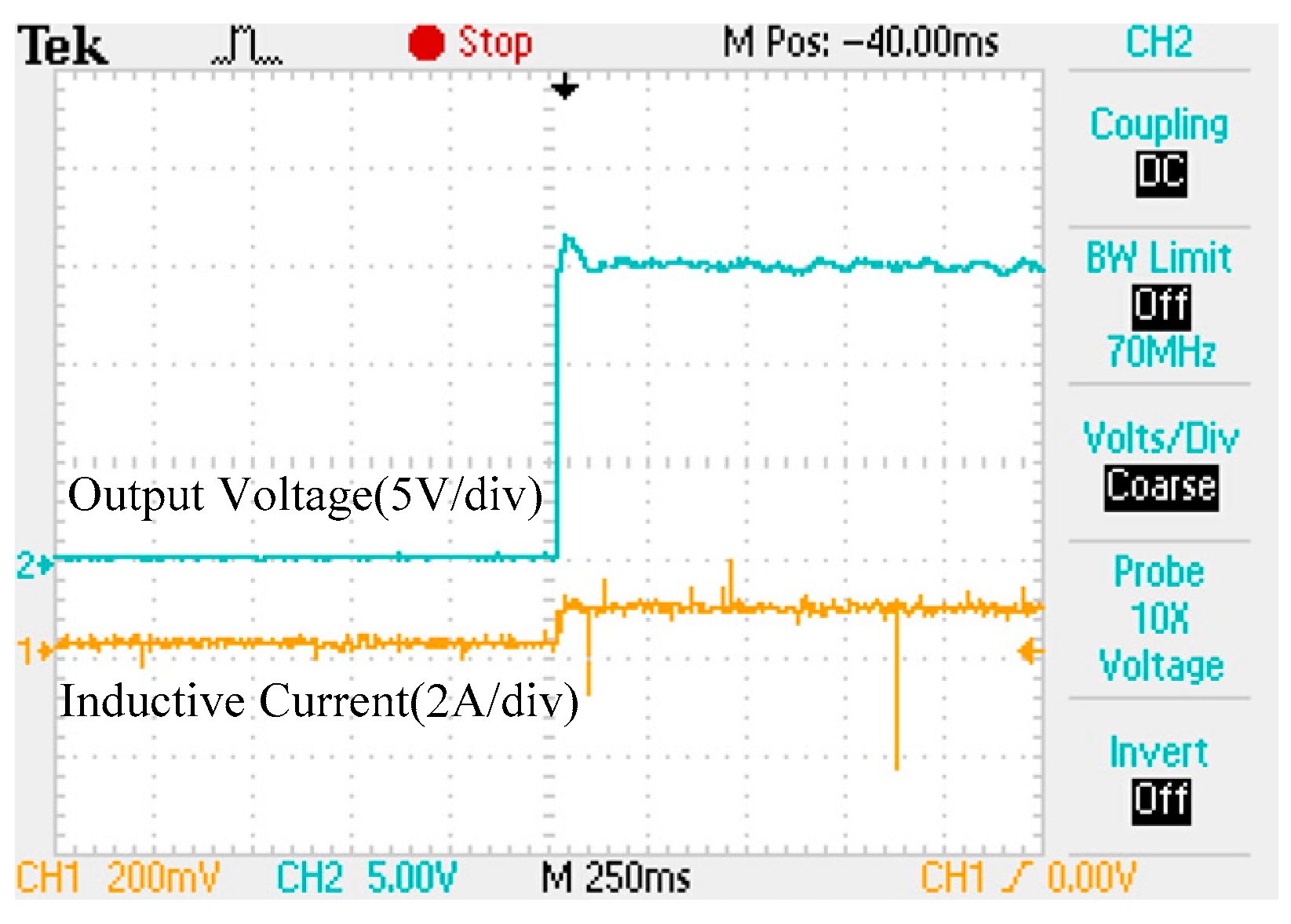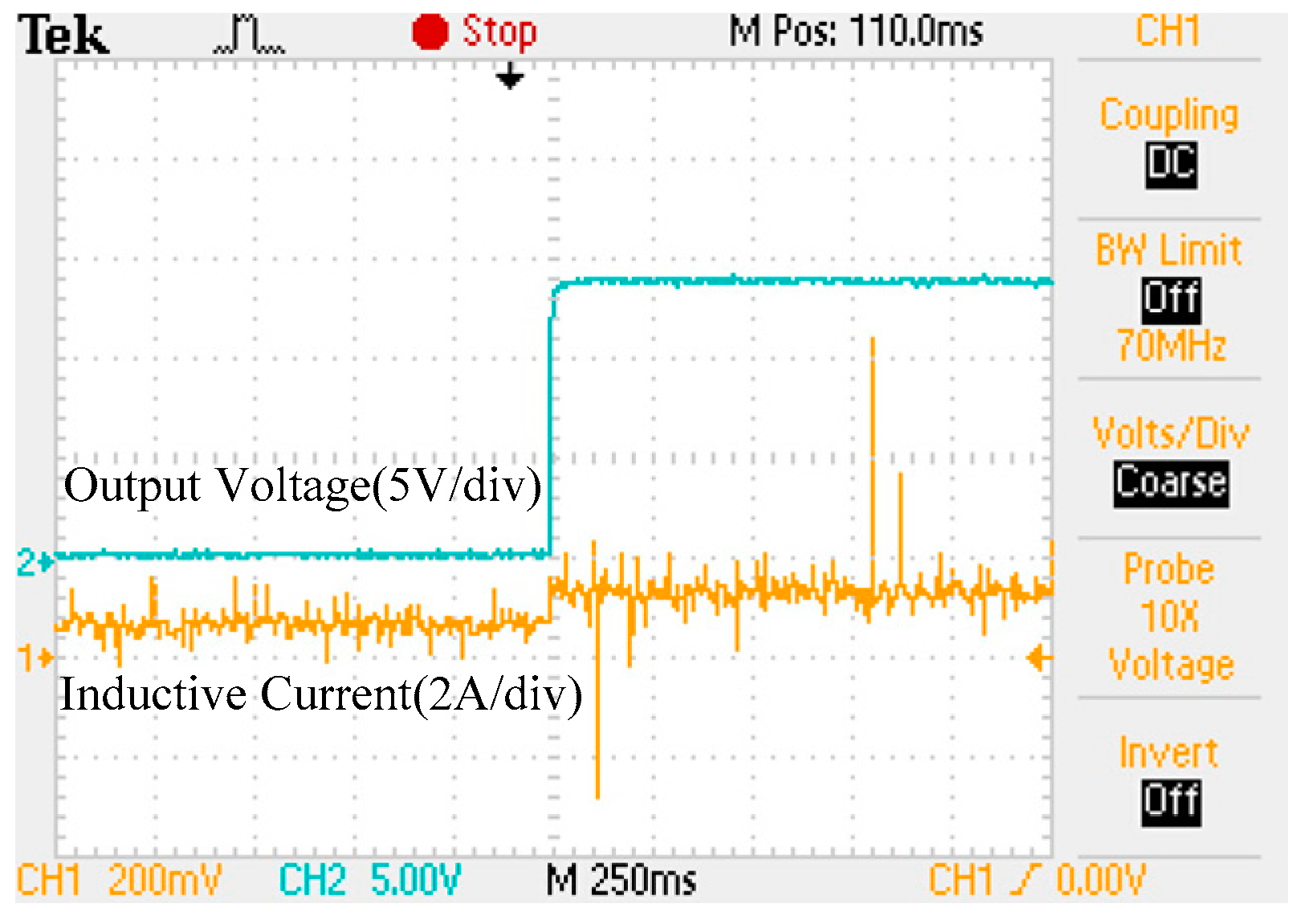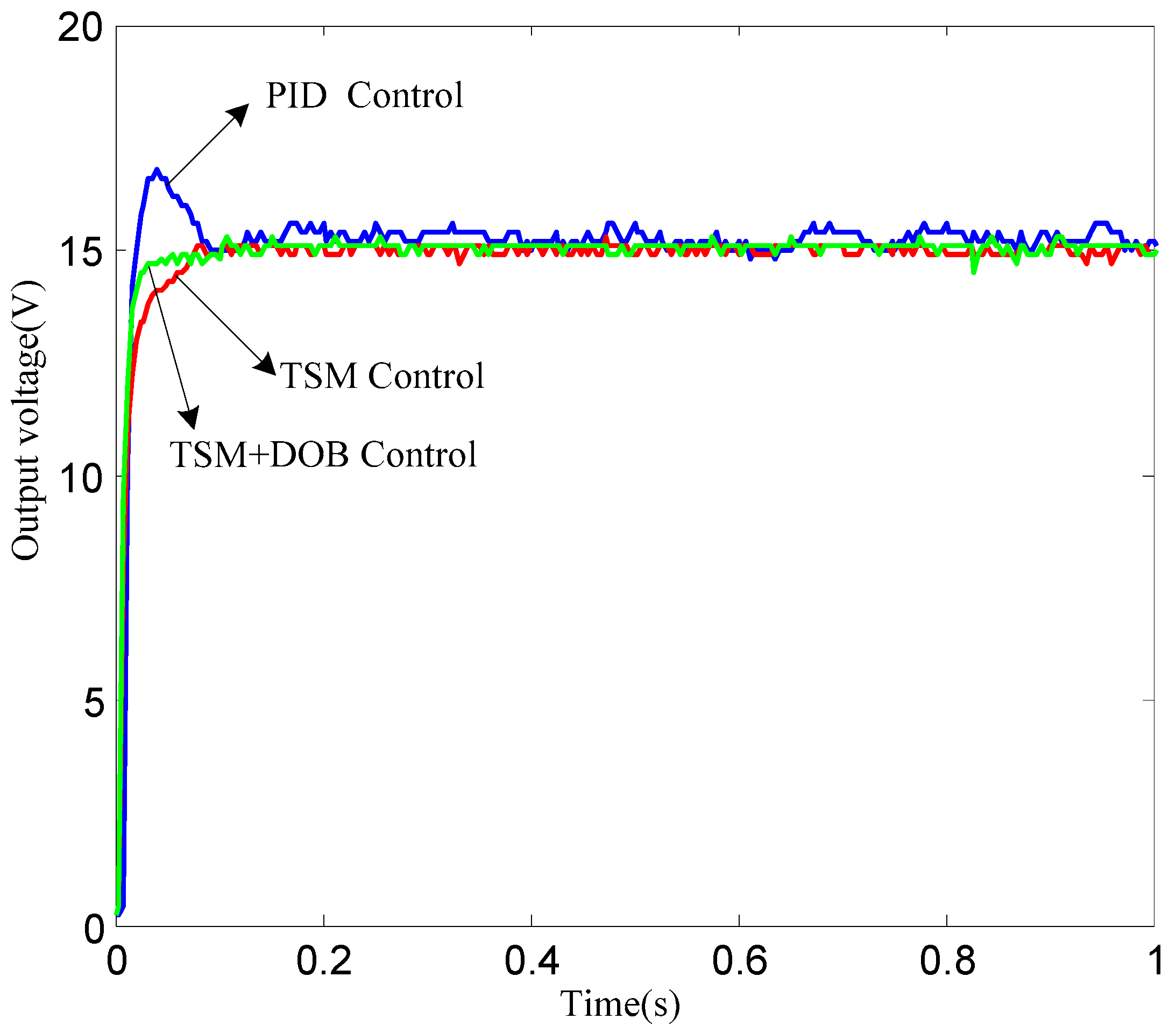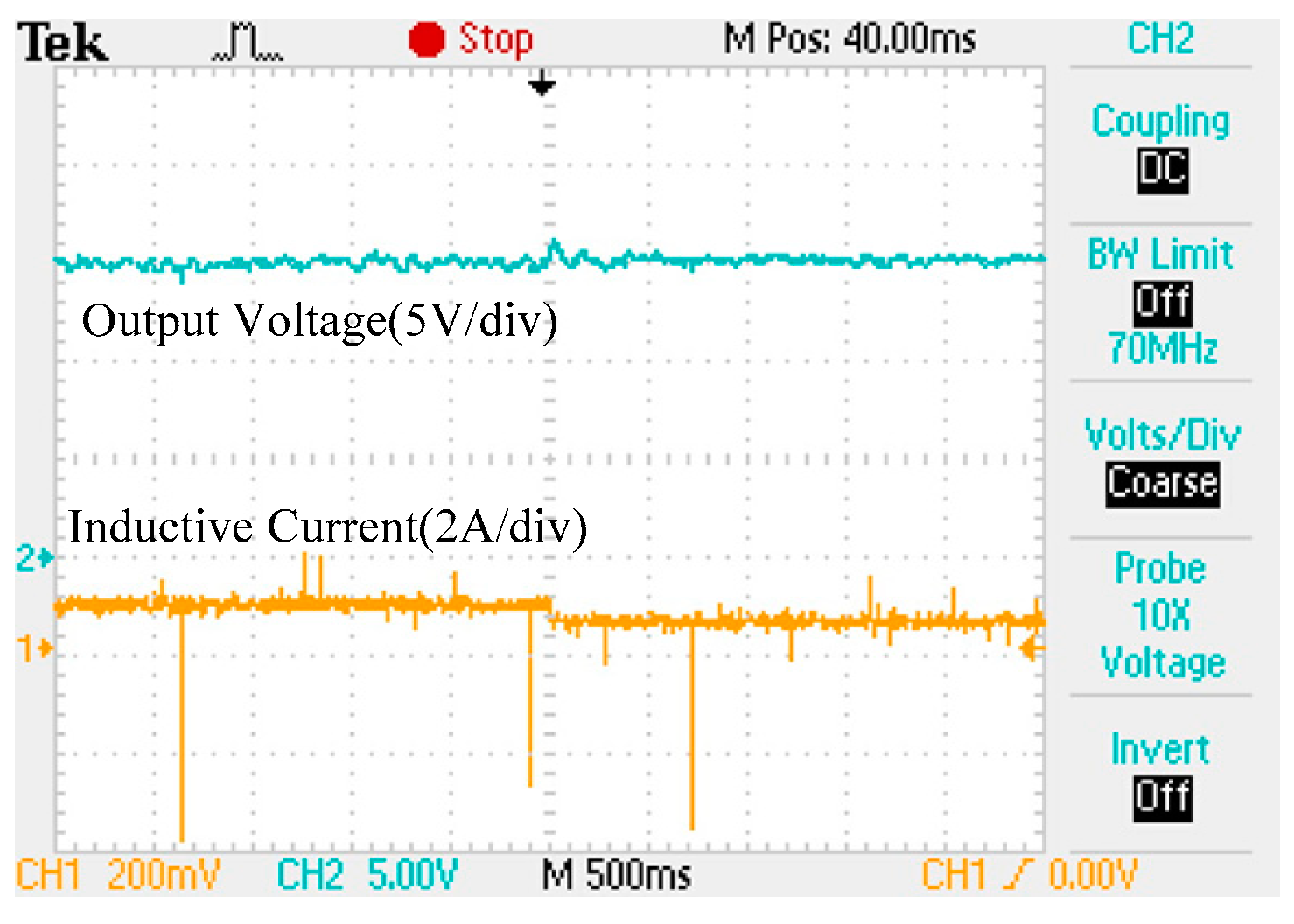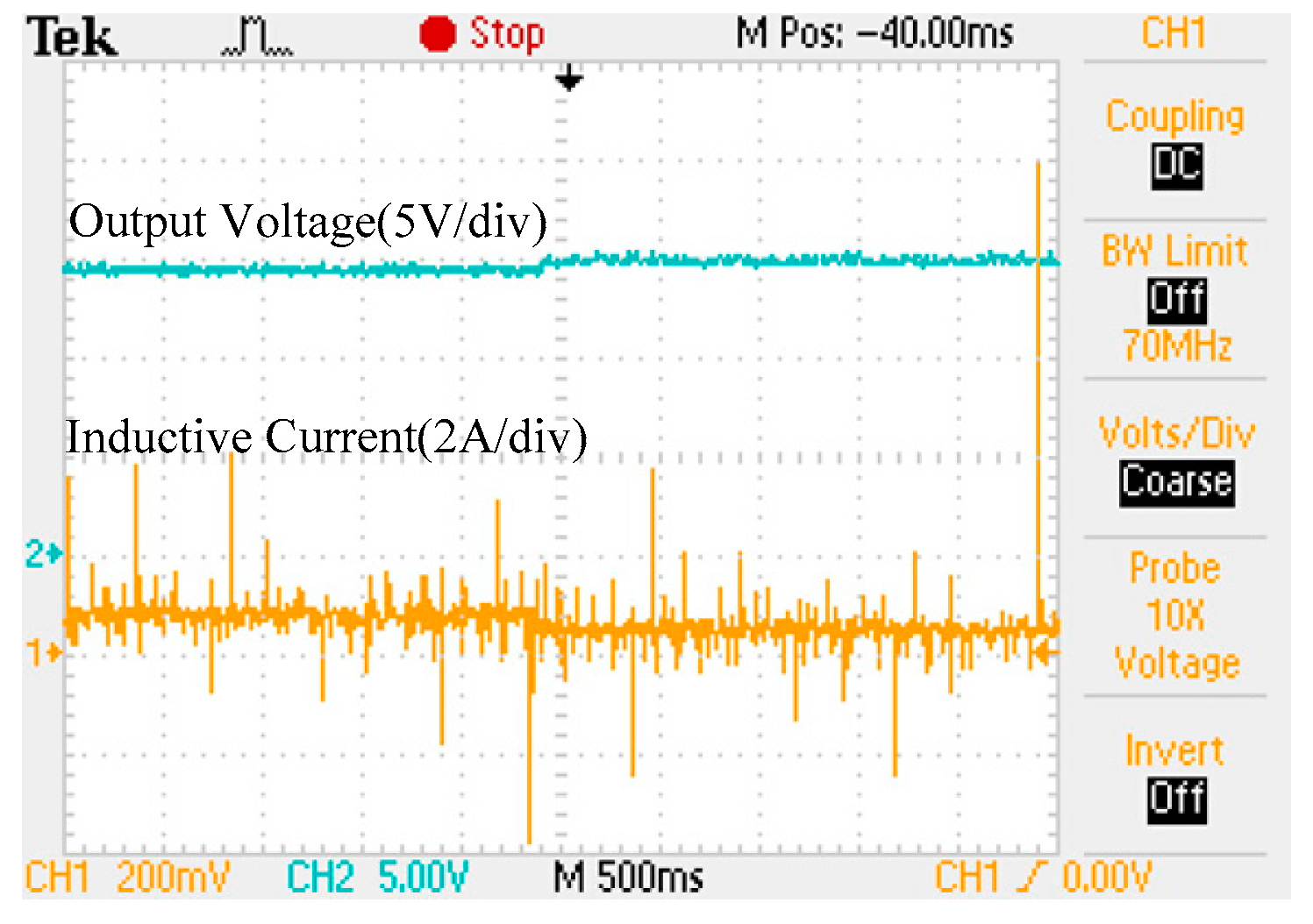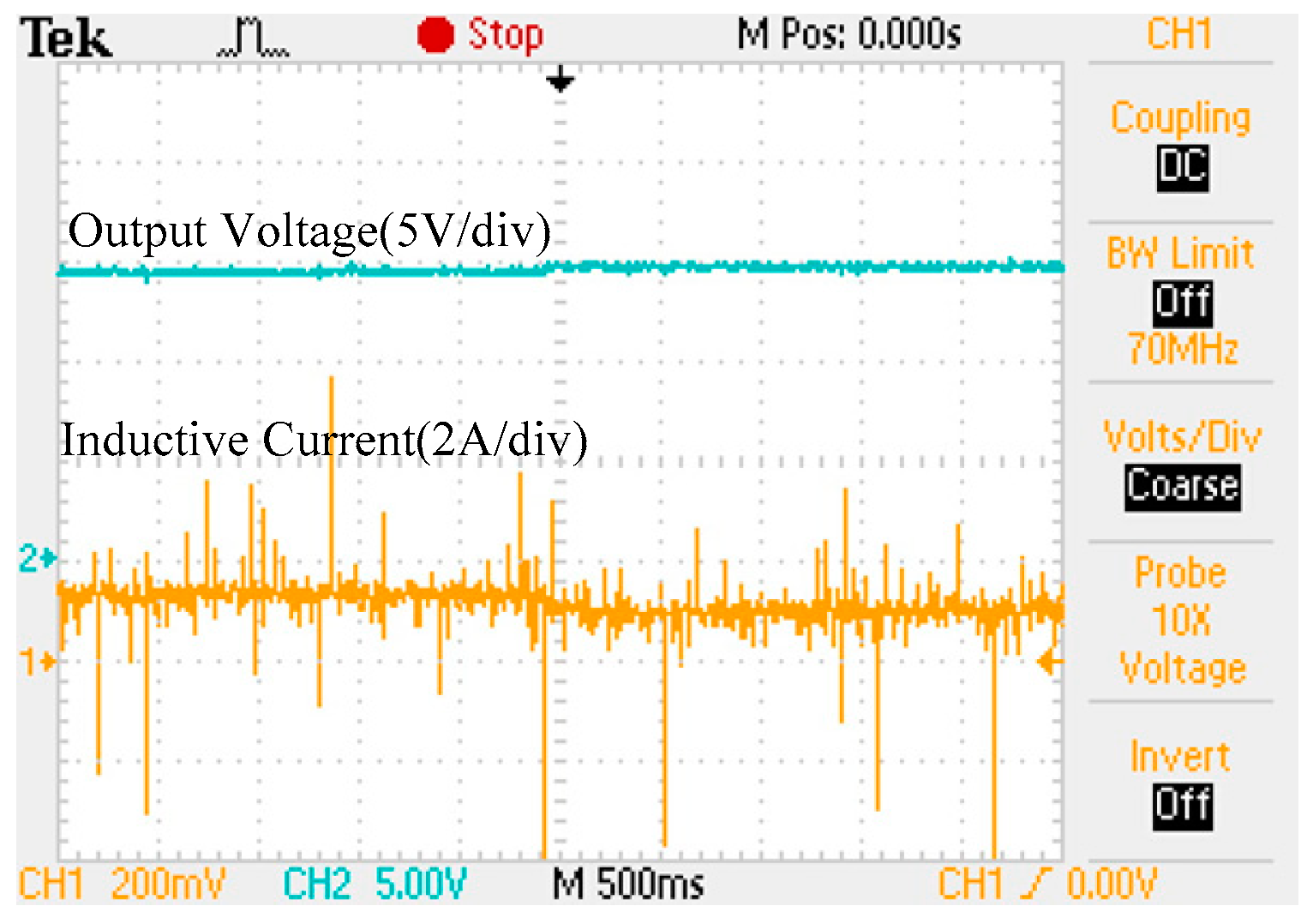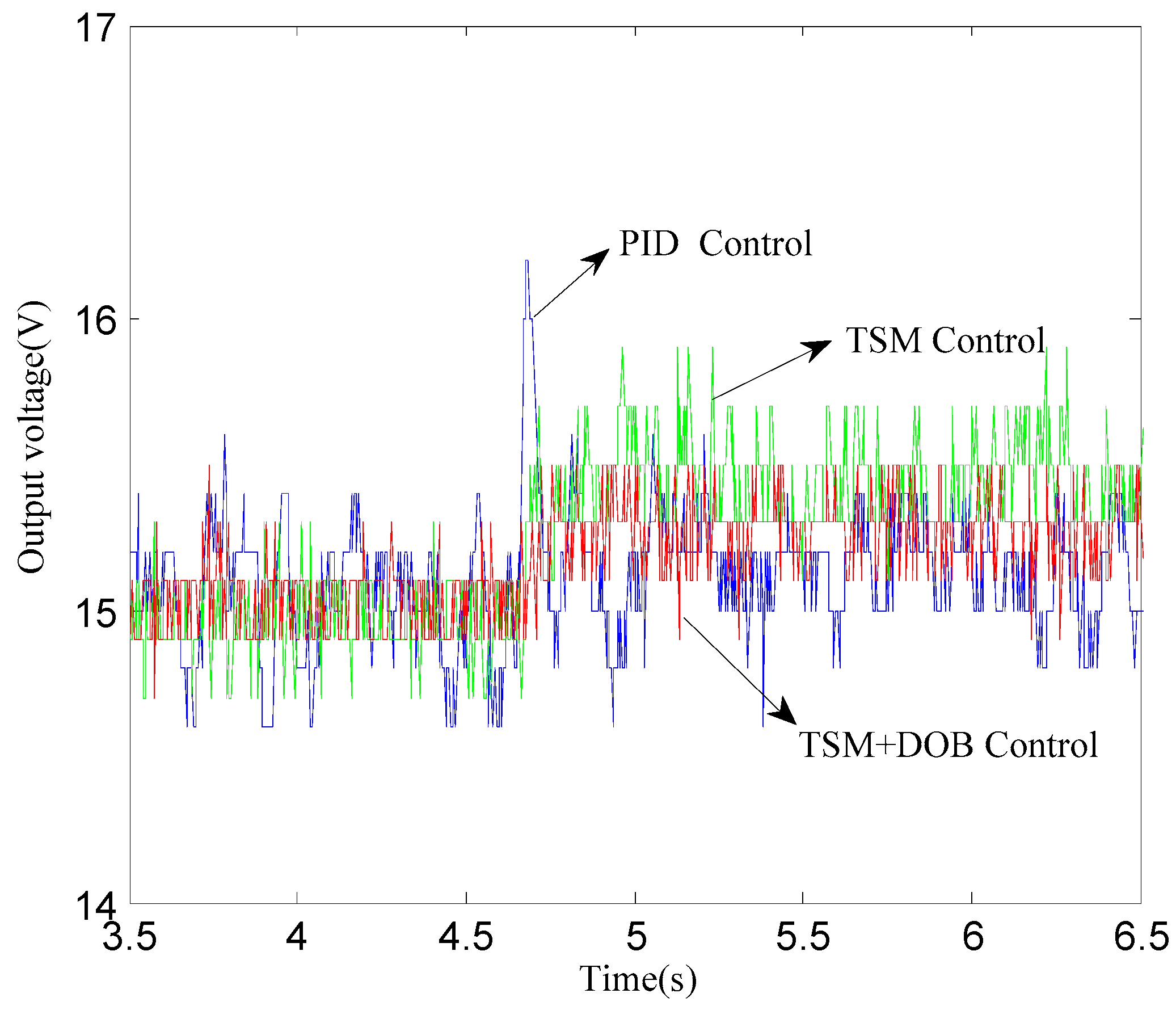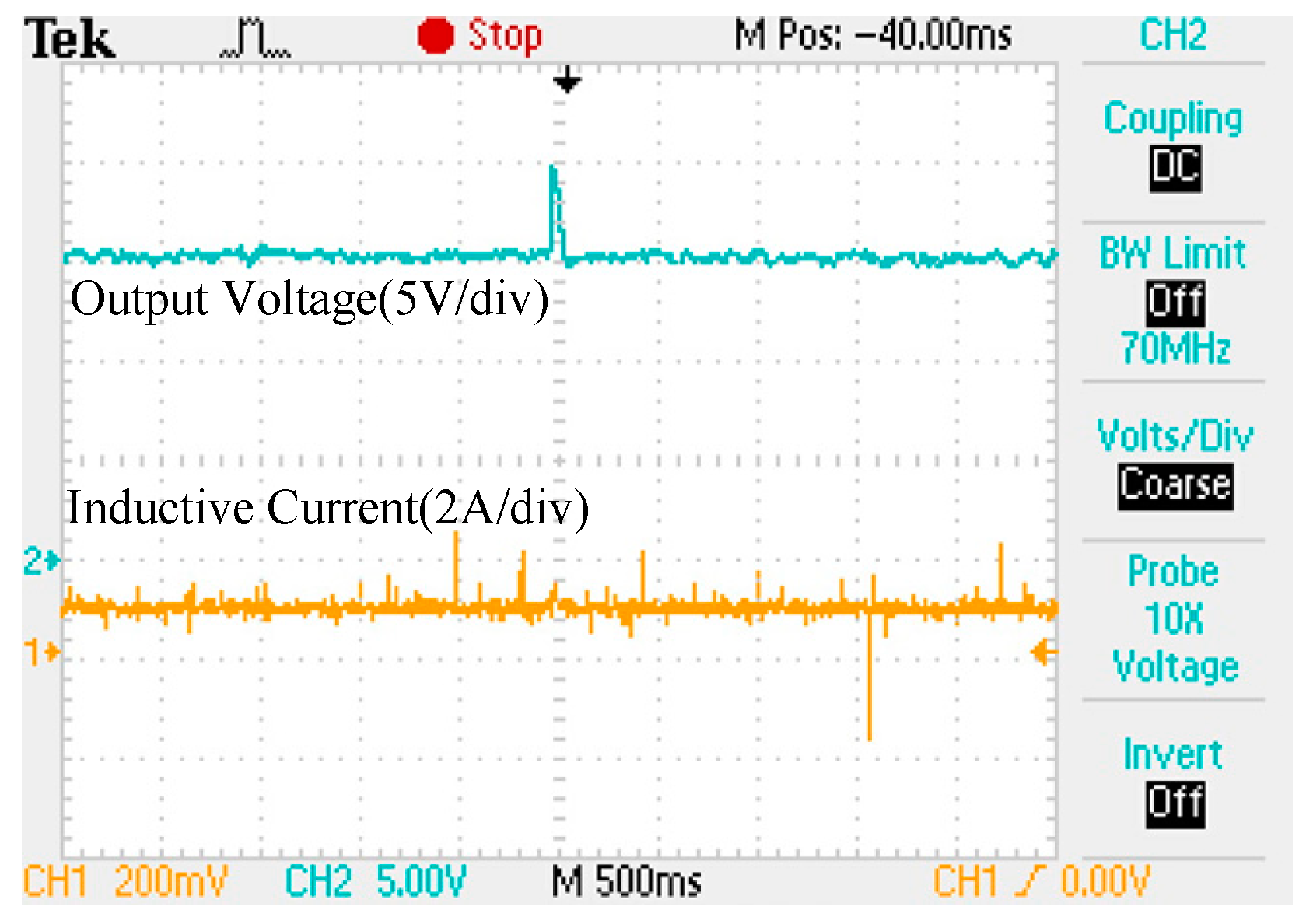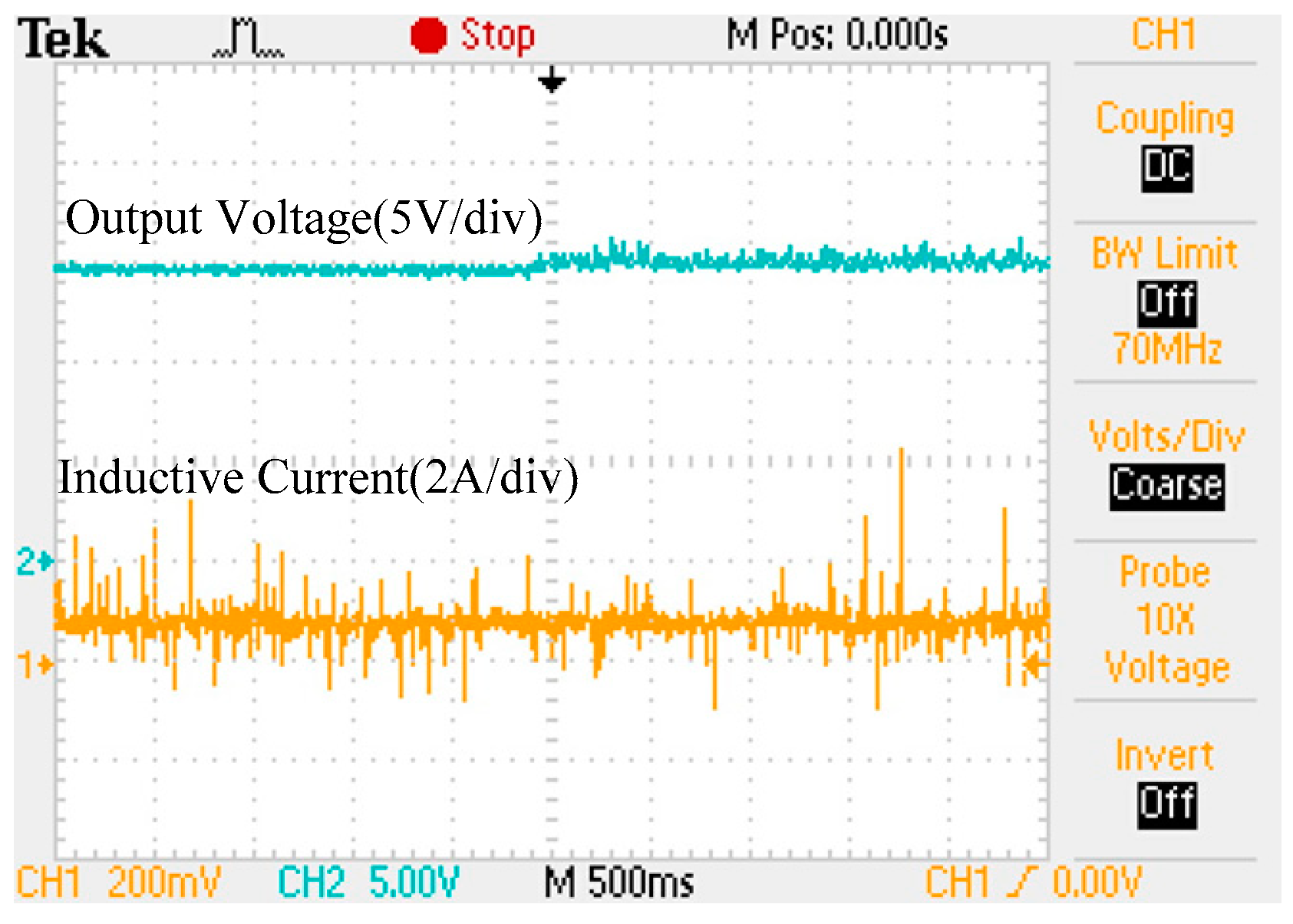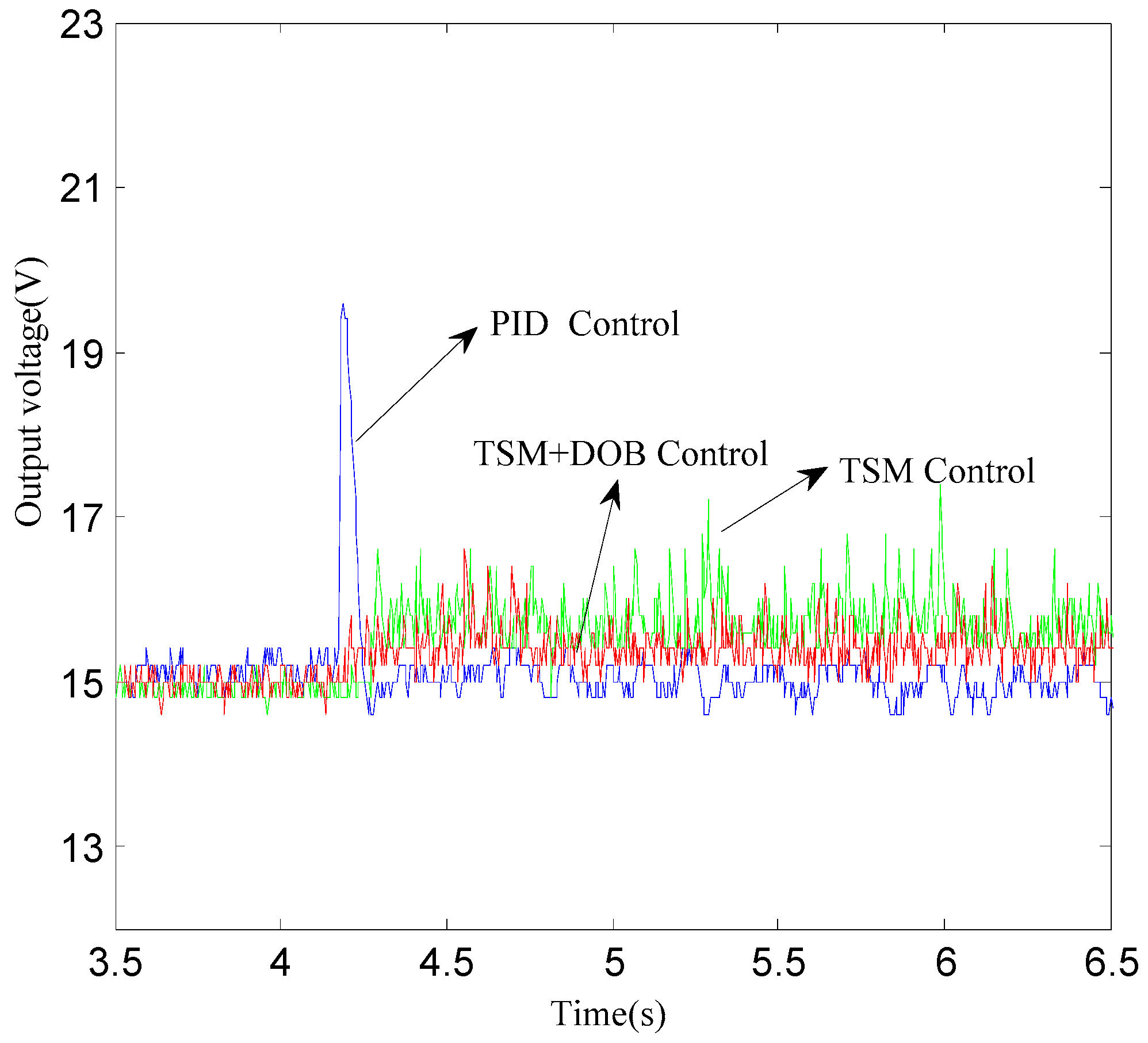1. Introduction
Switching power supplies are power conversion devices that provide the required voltage or current through different architectures. Although widely used in various fields, the control performances are not satisfactory under some large disturbance signals [
1,
2,
3,
4]. This is because most of them are based on proportional integral derivative (PID) control methods, while PID controllers may not overcome the adverse effect of large disturbance signals [
5,
6]. To this end, many scholars have devoted themselves to researching nonlinear controller designs for DC-DC converters, such as sliding mode control [
7,
8,
9], fuzzy control [
10,
11,
12], neural network [
13,
14], and intelligent control [
15,
16,
17]. Among them, sliding mode control has been found to be one of the most effective methods to handle nonlinear uncertain systems, since sliding mode control is insensitive to system uncertainties, external disturbances, and parameter perturbations [
18]. Consequently, sliding mode control has been applied to many practical systems, such as motors, power systems, robots, spacecraft, and servo systems [
19,
20,
21].
Recently, sliding mode has also been applied to the control of DC-DC converters. For example, a method to implement a global switching function in a sliding mode controller was reported in Reference [
22] for the first time, where the Buck converter’s steady-state operation and output voltage ripple was analyzed and the transient condition criteria of the global closed-loop sliding mode control system was proposed. Compared with traditional sliding mode control, the sliding mode method proposed in Reference [
22] exhibits faster transient load characteristics and better robustness. Also, the authors of Reference [
23] proposed a method of design for a proportional-integral-like sliding mode controller, which uses an adaptive controller to compensate the error caused by the load fluctuation, thereby reducing the system's steady-state error. Meanwhile, the sliding mode controller proposed in Reference [
23] also improves the steady-state and dynamic performance of the converter and facilitates the optimization of the controller parameters. Additionally, an adaptive terminal sliding mode (TSM) control strategy was proposed in Reference [
24], which ensures that the output voltage error converges to the equilibrium point within a finite time. Furthermore, the adaptive law in Reference [
24] can be integrated into the terminal sliding mode control strategy to achieve dynamic sliding during load fluctuation so as to improve the accuracy of system tracking. The authors of Reference [
25] proposed a novel nonsingular terminal sliding mode manifold incorporating a disturbance estimation technique subject to matched/mismatched resistance load disturbances, and the proposed controller was found to improve tracking performance and disturbance rejection ability against resistance load variation.
Although there are many sliding mode control results for DC-DC converters, most of them are pure state feedbacks [
26,
27]. This implies that when the lumped disturbances are large, the only method to improve the tracking accuracy is to tune the sliding mode controllers’ gains. It is known that the high-gain state feedback usually brings some shortcomings, such as a large overshoot, exciting unmodeled dynamics, and even instability [
28,
29]. Meanwhile, the high gains also bring the chattering problem [
30]. This is because the chattering is usually proportional to the magnitude of the discontinuous terms, while the high gains are always the parameters of these discontinuous terms.
To resolve the above problem, the idea of a compound controller was developed in this paper to improve the performance of the DC-DC Buck converter’s control system. By a combination of the nonsingular terminal sliding mode technique and the disturbance observer (DO) design method, a compound control scheme was developed step by step. The terminal sliding mode controller was designed to improve the disturbance rejection property, while the disturbance observer was constructed to further improve the dynamic performance of the closed-loop system. By comparing with the conventional terminal sliding mode and PID control schemes, the proposed compound algorithm was confirmed to provide a better dynamic and steady-state performance.
2. Problem Description
The circuit diagram of a Buck converter is shown in
Figure 1, consisting of a DC voltage source, a switch tube
, a diode
, an inductor
, a capacitor
, and a load resistor
.
is the inductive current,
is the output voltage, and
is the source voltage.
Since the switch has two states of “on” and “off”, the Buck converter also has two working modes. According to the two different conditions, the average state model of the Buck converter can be established as:
where
represents the switch state, which is 1 for the “on” state of the switch and 0 for the “off” state.
Furthermore, considering the effect of disturbance on the system modeling [
31,
32,
33], the above expression can be written as:
where the parameters
,
,
, and
are parameter perturbations, while
represents the corresponding system uncertainty and external disturbance. It is assumed that
and
are both bounded, and then Equation (2) can be transformed to the following form:
where
and
are expressed as:
Since , , , , and are all bounded, this implies that and are also bounded.
The control objective of this paper is to design a compound control scheme based on nonsingular TSM and nonlinear DO for the Buck converter, so that the desired value of the output voltage of the system can be quickly tracked under disturbance.
3. Compound Controller Design
3.1. Nonsingular Terminal Sliding Mode Controller
We set the output voltage error to be
, where
is the DC reference output voltage. Based on Equation (3), the system’s error dynamics can be expressed as:
where the system disturbance
includes both
and
, and can be expressed as:
Since
and its derivative are both bounded, from Equations (4) and (5), it is known that there exists constant
and
to make:
Let and .
Then, System (6) can be expressed as:
We designed the nonsingular terminal sliding mode surface as:
where
and
are odd integers, and
,
, and
satisfy:
,
,
.
The nonsingular terminal sliding mode controller was designed as:
where
,
is any real number. It can be verified that under Controller (11), the sliding variable will converge to the origin in a finite time.
The stability analysis of the finite-time convergence of closed-loop Systems (9) and (11) is given as follows.
Combined with Equation (9), the derivative of the sliding surface
is:
Substituting Controller (11) into Equation (12) yields:
It is clear from Equation (13) that:
With
and
in mind, we obtained:
Next, we needed to prove that under Controller (11), the state of System (9) will converge to zero within a finite time. On the one hand, it is easy to know that when the system state .
According to the finite-time Lyapunov theorem [
34,
35,
36,
37], the system state will converge to zero within a finite time. On the other hand, when the system trajectories stay in the line
, substituting Controller (11) into System (9) produces the following:
which implies that when
, there is:
It is clear from Equation (17) that when ; conversely, when . This means that the trajectory of the system will not stay on the axis .
In conclusion, under Controller (11), the state of System (9) will converge to zero within a finite time.
Controller (11) is discontinuous and has severe chattering problems. In this paper, we employed the boundary layer method to eliminate the chattering, and thus the nonsingular terminal sliding mode Controller (11) can be rewritten as:
where the saturation function
can be defined as:
.
3.2. Nonlinear Disturbance Observer Design
Consider the following nonlinear system:
where
,
,
,
are the system state, system input, disturbance, and system output respectively;
,
,
, and
are known functions.
According to the theory of disturbance observer [
38], the nonlinear disturbance observer is designed as:
where
P is an internal state of the nonlinear DO. By combining Equation (20) and Buck converter’s sliding mode control system model, expressed by System (12), the following disturbance observer can be designed:
The stability of the above disturbance observer is given as follows.
Letting
, the derivative of the disturbance deviation is:
Substituting (18) and (21) into Equation (22), the following can be obtained:
Select a Lyapunov function as:
Taking a derivative of
along System (23) yields:
From Equation (8), it is clear that
, which indicates that:
It can be easily verified that the disturbance error will converge to a small area of the origin.
In conclusion, a compound controller obtained by combining the terminal sliding mode state feedback (Equation (18)) and disturbance observer (Equation (21)) can be constructed as follows:
Remark 3.1: From a theoretical point of view, the boundary level should be as small as possible. However, the small saturation level may cause chattering problems. Hence, the choice of the boundary level is a trade-off. For the disturbance observer, it can be seen from Equation (23) that a larger implies a smaller observation error. However, it is interesting that when we tune the parameter to be large enough, the performance of the observation will be unchanged. This may be caused by the hardware.
The block diagram of the compound controller for the Buck converter is shown in
Figure 2, where the output voltage and inductive current information can be obtained from sensors, and the control output will generate a pulse width modulation (PWM) signal.
4. Simulation Analysis
To verify the feasibility and effectiveness of the proposed algorithm, MATLAB simulations were performed under three kinds of disturbance: start-up, step-load, and step-input-voltage. The converter parameters are given in
Table 1.
In order to show the advantages of the proposed algorithm, the traditional PID control, terminal sliding mode control (TSM) and compound control (TSM + disturbance observer (DOB)) methods were compared. Firstly, the controller parameters were tuned so that the system under each controller could obtain the best convergence performance. The criterion was to tune the parameters to achieve the fastest convergence without considering the disturbance rejection property. Based on this, the PID parameters were taken as
,
, and
, while the parameters of Controllers (18) and (27) were set as
,
, and
. The boundary layer level was set as
and the disturbance observer parameter was chosen to be
. For comparison, the simulated start-up waveforms of the traditional PID control, terminal sliding mode (TSM) control, and the compound control (TSM + DOB) methods are shown in
Figure 3. The convergence times for the first two cases were both about 0.4 s, while the compound control was found to converge to zero much more quickly—within 0.1 s.
For the disturbance rejection property, the PID controller was always worse than the TSM and compound controllers. This is because the steady-state error under TSM and the compound controllers can be steered to the origin in a finite time, while there always exists a steady-state error under the PID controller. This also implies that no matter what values of parameters are selected, the disturbance rejection properties of the TSM and compound controllers in the simulation will always be better than that of the PID controller.
As a matter of fact, from a theoretical point of view, the steady-state error under TSM could be zero in a finite time, while the steady-state error under PID will always be restricted in the region of origin. It is apparent that from the theoretical point of view that the TSM controller could provide a better disturbance rejection property than the PID controller. Hence, we omitted the simulation performed under PID. In
Figure 4, the load resistance steps from 25 Ω to 500 Ω at
t = 1 s, and back to 25 Ω at
t = 1.5 s. The output voltage has a response similar to that of the load resistance. Under the compound controller, it can be observed that the output voltage can return to the steady-state value quickly, and its convergence speed is obviously faster than that of the terminal sliding mode (TSM) controller. The response curves of the inductive current to the step-load are shown in
Figure 5. It can also be seen that the current under the compound control can return back to its steady-state value quickly. Therefore, one can conclude that the compound controller with the disturbance observer can provide the system with a faster response speed and better disturbance rejection performance.
The simulated waveform of the output voltage and inductive current with respect to the input voltage stepping from 30 V to 40 V at
t = 1 s and back to 30 V at
t = 1.5 s are shown in
Figure 6 and
Figure 7, respectively.
Figure 6 shows that the value of the output voltage increases with the rise of the input voltage. Compared with the traditional terminal sliding mode control, it can be observed that the compound controller with the disturbance observer makes a smaller amplitude change and can quickly converge to the desired value. From
Figure 7, we can see that the inductive current under both controllers exhibits a sudden change under TSM and TSM + DOB controllers when the input voltage changes. Nevertheless, the inductive current under the compound controller will reach the steady state rapidly, while the current under the traditional terminal sliding mode controller needs a period of recovery time to reach its steady-state value. In summary, the compound controller has a better control performance.
5. Experimental Verification
The circuit used in this experiment, shown in
Figure 8, was the main circuit of a Buck converter with a 30-V DC voltage as the input. The control algorithms were implemented using digital signal processing (DSP) TMS320F28335 (Texas Instruments Inc., Dallas, TX, USA) with a clock frequency of 150 MHz. The voltage detection adopted the method of parallel resistance, which connects the two series resistors in parallel and adjusts their proportional relationship to meet the voltage sampling range of 0–3.3 V for DSP. The inductive current was measured using the ACS712 current module (Allegro MicroSystems LLC, Worcester, CM, USA). The analog signals of output voltage and inductive current were converted to digital signals through two 12-b analog-to-digital (A/D) converters. The resolution of digital pulse width modulation (DPWM) was 16 bits. The drive circuit adopted TLP250 (Toshiba Inc., Minato-ku, Tokyo, Japan) produced by Toshiba, and the PWM output of DSP was taken as its input signal. Meanwhile the IR2110 chip (International Rectifier Inc., Los Angeles, SC, USA) was bootstrapped, so that the PWM output amplitude was enough to operate the switch. The schematic diagram of the hardware is shown in
Figure 8. The TLP250 provided both isolation and driving. In order to stabilize its built-in high-gain amplifier, a small ceramic capacitor and two current-limiting resistors must be placed between b1 and b3. The parameters of the components depend on the operating current of the luminous diode in the chip.
The software of this experiment used DSP as the control chip of the control loop. DSP is widely used in various fields of power electronics because of its fast execution speed, high efficiency, multi-function, and real-time control. The block diagram of the experimental platform is shown in
Figure 9. The experimental setup is shown in
Figure 10.
The parameters of the electronic elements are: = 330 , = 1000 , = 50 . The TSM coefficients are: , , , while the PID control parameters are: , , .
When the input voltage is 30 V and the reference value of the input voltage is 15 V, experimental DC coupled start-up waveforms of the output voltage and inductive current under three control schemes (PID, TSM, TSM + DOB) are shown in
Figure 11,
Figure 12 and
Figure 13. The experimental start-up comparisons of the output voltage are given in
Figure 14.
Table 2 gives the comparisons of overshoot, rising time, and settling time under PID, TSM, and TSM + DOB controllers at the start-up. It can be seen that the overshoot under the TSM + DOB controller is smaller than that under the other two control modes. The rising time under the TSM + DOB controller is shorter than that under the other two control modes, with the related rates of 36.4% and 145.5% when comparing with the PID and TSM control modes, respectively. In addition, the settling time under the TSM + DOB controller is also smaller than that under the PID and TSM control modes, with the related rates of 154.5% and 54.5%, respectively.
Experimental DC coupled step-load waveforms of the output voltage and inductive current under three control schemes (PID, TSM, TSM + DOB) when the load steps from 50
to 100
are shown in
Figure 15,
Figure 16 and
Figure 17, and the experimental step-load comparisons of the output voltage are given in
Figure 18.
Table 3 gives the comparisons of overshoot and settling time under PID, TSM, and TSM + DOB control modes when the step-load changes. It can be seen that the overshoot under the TSM + DOB controller is smaller than that under the other two control modes. The settling time under the TSM + DOB controller is also shorter than that under the other two control modes, with the related rates of 218.0% and 14.8% when comparing with the PID and TSM control mode, respectively.
Experimental DC coupled step-input-voltage waveforms of the output voltage and inductive current under three control schemes (PID, TSM, TSM + DOB) when the input voltage steps from 30 V to 35 V are shown in
Figure 19,
Figure 20 and
Figure 21, and the experimental step-input-voltage comparisons of the output voltage are given in
Figure 22.
Table 4 gives the comparisons of overshoot and settling time under PID, TSM, and TSM + DOB control modes when the step-input-voltage changes. It can be seen that the overshoot under the TSM + DOB controller is smaller than that under the other two control modes. Moreover, the settling time is also shorter than that under the other two control modes, with the related rates of 59.1% and 20.6% when comparing with the PID and TSM control modes, respectively.
From the above experimental results, we can see that in the absence of external disturbances, the terminal sliding mode controller combined with the disturbance observer can quickly reach the desired value, with the overshoot and convergence time being significantly less than those achieved under the other two control schemes. Furthermore, when some disturbances exist, such as the step-load and input-voltage changes, the output voltage of the Buck converter under the compound controller provides the best robustness property. This was confirmed by comparing the overshoot and settling time of the compound controller with those of the other two controllers. The compound controller was found to improve the closed-loop system of Buck converters in two aspects. One is the convergent speed, which implies that the output voltage will converge to the desired voltage rapidly at the start-up. The other is the disturbance rejection property, which provides the control system with strong robustness.
